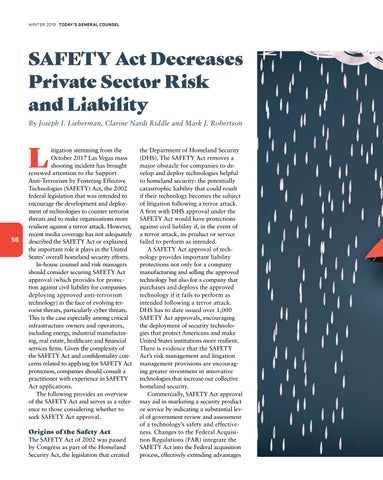WINTER 2019 TODAY’S GENER AL COUNSEL
SAFETY Act Decreases Private Sector Risk and Liability By Joseph I. Lieberman, Clarine Nardi Riddle and Mark J. Robertson
L 56
itigation stemming from the October 2017 Las Vegas mass shooting incident has brought renewed attention to the Support Anti-Terrorism by Fostering Effective Technologies (SAFETY) Act, the 2002 federal legislation that was intended to encourage the development and deployment of technologies to counter terrorist threats and to make organizations more resilient against a terror attack. However, recent media coverage has not adequately described the SAFETY Act or explained the important role it plays in the United States’ overall homeland security efforts. In-house counsel and risk managers should consider securing SAFETY Act approval (which provides for protection against civil liability for companies deploying approved anti-terrorism technology) in the face of evolving terrorist threats, particularly cyber threats. This is the case especially among critical infrastructure owners and operators, including energy, industrial manufacturing, real estate, healthcare and financial services firms. Given the complexity of the SAFETY Act and confidentiality concerns related to applying for SAFETY Act protection, companies should consult a practitioner with experience in SAFETY Act applications. The following provides an overview of the SAFETY Act and serves as a reference to those considering whether to seek SAFETY Act approval.
Origins of the Safety Act The SAFETY Act of 2002 was passed by Congress as part of the Homeland Security Act, the legislation that created
the Department of Homeland Security (DHS). The SAFETY Act removes a major obstacle for companies to develop and deploy technologies helpful to homeland security: the potentially catastrophic liability that could result if their technology becomes the subject of litigation following a terror attack. A firm with DHS approval under the SAFETY Act would have protections against civil liability if, in the event of a terror attack, its product or service failed to perform as intended. A SAFETY Act approval of technology provides important liability protections not only for a company manufacturing and selling the approved technology but also for a company that purchases and deploys the approved technology if it fails to perform as intended following a terror attack. DHS has to date issued over 1,000 SAFETY Act approvals, encouraging the deployment of security technologies that protect Americans and make United States institutions more resilient. There is evidence that the SAFETY Act’s risk management and litigation management provisions are encouraging greater investment in innovative technologies that increase our collective homeland security. Commercially, SAFETY Act approval may aid in marketing a security product or service by indicating a substantial level of government review and assessment of a technology’s safety and effectiveness. Changes to the Federal Acquisition Regulations (FAR) integrate the SAFETY Act into the Federal acquisition process, effectively extending advantages
